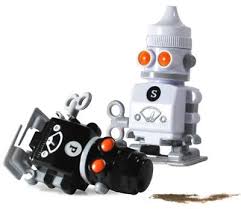 Investor money has forever flowed to innovation in robotics. Robots on the Digital Health at CES offered a view of what was new then in human-like robots, the most charming was Anybots QB, now QB2 – which would ‘go to the office for you.’ In fact, this ‘telepresence’ robot begs the question, what’s a robot anyway – is it a ‘machine controlled device through an external or (usually internal) computer, often equipped with audio, visual, and/or tactile sensors as well as other devices and tools to perform one or several programmed jobs.’ Oh yeah. They can be autonomous, like the iRobot one for the military – working on their own. Like Anybots, they could be a telepresence robot – a “remote controlled, wheeled device that has wireless internet connectivity.” And the market for all types in healthcare globally some say is $2.8 billion.
Investor money has forever flowed to innovation in robotics. Robots on the Digital Health at CES offered a view of what was new then in human-like robots, the most charming was Anybots QB, now QB2 – which would ‘go to the office for you.’ In fact, this ‘telepresence’ robot begs the question, what’s a robot anyway – is it a ‘machine controlled device through an external or (usually internal) computer, often equipped with audio, visual, and/or tactile sensors as well as other devices and tools to perform one or several programmed jobs.’ Oh yeah. They can be autonomous, like the iRobot one for the military – working on their own. Like Anybots, they could be a telepresence robot – a “remote controlled, wheeled device that has wireless internet connectivity.” And the market for all types in healthcare globally some say is $2.8 billion.
But what about seniors – have they benefited from well-funded robotics’ innovations? Not so much, and not yet. The question might be, will they? It is certainly not for lack of trying, and not for lack of need. Each of the attempted applications have been focused on solving a real problem, whether it is remote consultation with a physician or caregiver, providing emotional support and companionship, or assisting a senior with an otherwise impossible task. There have been a number of senior-focused initiatives in the past decade -- from Japan’s Paro the Seal (initially $6000), Cyberdine’s HAL to Softbank’s very charming NAO, under development since 2006 and a great hit at summits. There have been a few publicized senior-related use of robots, including used for telepresence in a senior living community, a great use to connect seniors to long distance family.
How do smarter table-top devices impact the table-top robot? Consider the Amazon Echo Show – a tabletop unit that enables speaking to, i.e. dropping in on, long distance family without typing or swiping. Now consider that it is $299. The Kubi robotic swivel stand, used for remote directional positioning, was offered in 2016 with grandPad, is currently priced at $699. Oops, and that’s without the tablet, and Revolve Robotics seems to have, uh, repositioned into telehealth. Meanwhile, several well-funded initiatives seem to have focused on the table-top version. The most notable of these are Jibo, recipient of $72 million (!) of funding to date, and Intuition Robotics’ ElliQ, recipient of $14 million Series A funding, announced July 11.
For seniors and those who serve them, what makes sense moving, uh, forward? Remote control navigation of tele-presence robots (essentially video conferencing on a remote-controlled stand) seems to make sense in hospitals, where remote consultation/sharing is a necessity. Possibly useful in senior living communities with the right tech support from staff. Perhaps useful for physical therapy rehabilitation (post stroke, for example). As for the social robot, like ElliQ and Jibo, it would make sense to leverage that investment in software, now that Amazon’s Echo Show has reduced the utility of a tabletop robot, into migrating it to interactive and mobile robots that can help and interact with various seniors in resource-constrained areas, like senior Emergency Rooms, Skilled Nursing Facilities, and Assisted Living Memory care units. How they are managed, administered, charged up, stored, safely navigated – all that remains to be revealed.
from Tips For Aging In Place https://www.ageinplacetech.com/blog/robotics-and-older-adults-2017-are-we-there-yet
No comments:
Post a Comment
Note: Only a member of this blog may post a comment.